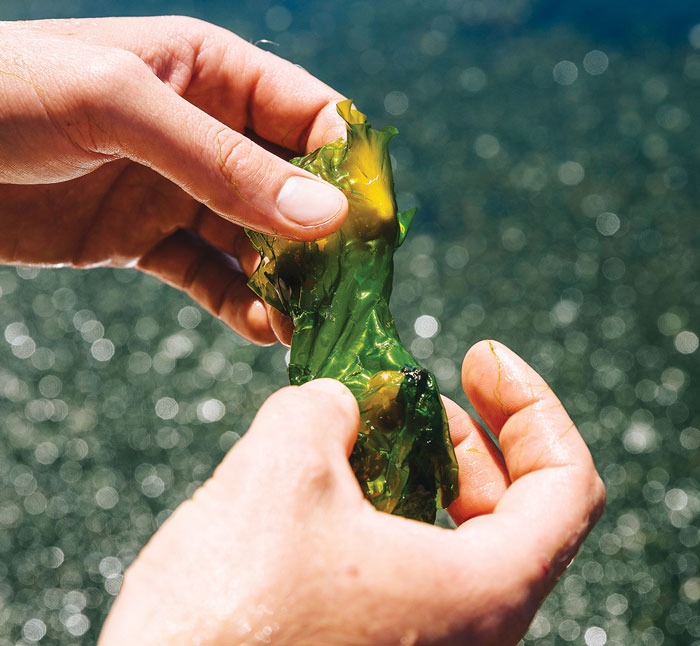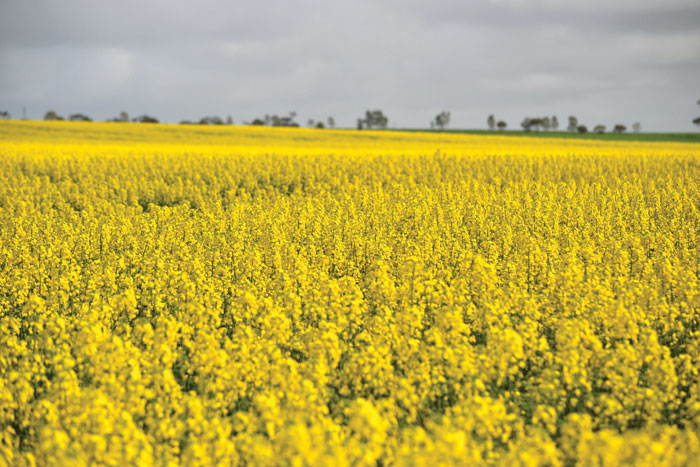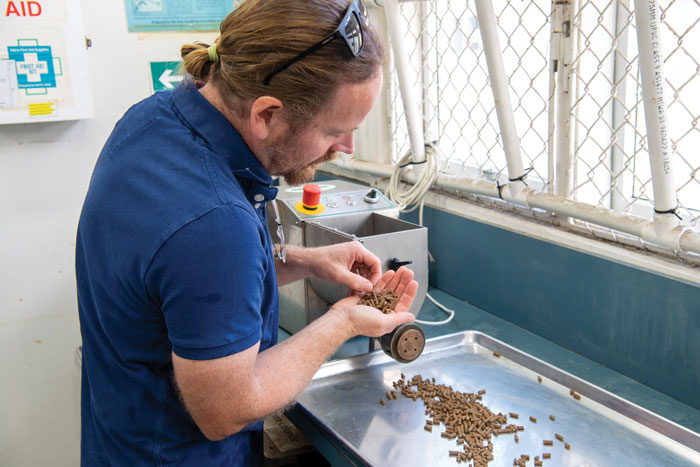The development of innovative feed ingredients is helping the aquaculture industry end its reliance on wild-caught fish in aquafeeds, with Australian research contributing to international efforts
By Gio Braidotti and Catherine Norwood
Limits on the availability of forage fish as a key ingredient in many aquafeeds has long been recognised as a major impediment to the aquaculture sector’s growth. Research globally has been driving innovation in feed formulations that continue to reduce the proportion of fishmeal and fish oil in feeds for cultured aquatic species. Aquaculture done well has the potential to be the most environmentally efficient of all food production systems and to provide the most sustainable source of high-value animal protein.
Historically, wild-caught small pelagic or forage fish have been an important ingredient in aquafeeds. They contribute to the health of farmed fish and to the nutritional value of the fish produced for human consumption, providing protein and healthy long-chain omega-3 fatty acids that both fish and people need.
Over the past two decades, innovation in feed and farming technologies has seen substantial improvements in feed efficiencies. For example, the quantities of fishmeal required to produce one kilogram of Atlantic Salmon – the fish in:fish out ratio – has improved from 4:1 to less than 1:1.

Growing demand for feed
Despite these improvements, the rise of aquaculture continues to place significant pressure on forage fish stocks, and continued reliance on these stocks restricts the sector’s growth and creates a reputational risk around the sustainability of farmed product. This is the case even when fishmeal is sourced from sustainably certified fisheries, which is driving the search for alternative ingredients.
A research team from James Cook University in Queensland recently published a review of global demand and opportunities for new ingredients in the paper ‘The Future of Aquatic Protein: Implications for Protein Sources in Aquaculture Diets’.
The researchers found the growth of demand for aquafeeds increased sixfold between 1995 and 2015, outstripping the growth of aquaculture itself, which increased fourfold over the same period. Aquafeed demand rose from 7.6 million tonnes globally in 1995 to 47.7 million tonnes in 2015. The review anticipates demand will reach 87.1 million tonnes by 2025.
The researchers concluded alternative sources will be crucial to meeting this demand because the supply of wild-caught forage fish remains uncertain.
“The availability of sustainably fished small pelagics for fishmeal and oil has not increased in 24 years, and their inclusion levels in aquafeeds must be decreased at a greater rate for aquaculture to provide an increasingly large proportion of healthy seafood to an expanding global population,” the review says.
It identifies land-based plant proteins and animal by-products as important contributors in supplying the additional 37.4 million tonnes of aquafeeds needed, and these are already widely used. However, there are limits on the expansion of terrestrial plant and animal production without adding stress to land, water and phosphorus resources.
The report identifies five additional sources of essential ingredients that will be of increasing importance: fishery and aquaculture by-products; food waste; insects; microbial biomass; and macroalgae (seaweeds). Australia has already invested significantly in research and development targeting alternative feed ingredients.
Traditional plant proteins
Plants are commonly used as protein following suitable processing to render them digestible to fish and to neutralise antinutrients in grains that can actually harm fish. Plant materials used include soybean, corn gluten, lupin, faba beans and rapeseed meal.

Omega-3s from canola
Genetic technologies have been used to develop enhanced crops that could be used in aquafeeds. This includes a bioengineered variety of canola that produces the essential omega-3 fatty acids as a potential replacement for the fish oil components in aquafeeds.
CSIRO researchers developed this new canola in partnership with Nuseed Ltd and Australia’s Grains Research and Development Corporation. Nuseed is coordinating the global commercialisation of the crop, which has been approved for use in animal feed and foods in Australia, New Zealand and the US.
Fishery and aquaculture by-products
These are the trimmings rejected for human consumption that include viscera, heads, skin, bones and blood. In 2019, fishery by-products provided 20 per cent of the volume of fishmeal, but aquaculture contributed just 10 per cent. This indicated there were opportunities to develop the processing capacity of aquaculture to intercept additional by-products and increase the proportion used for fishmeal.
Improved hydrolysates
Curtin University in Western Australia has been working with several industry partners and FRDC projects to refine the processes used to create protein-based hydrolysates from fish waste. This includes a project with SAMPI in South Australia, which processes the state’s harvest of ranched Southern Bluefin Tuna (SBT, Thunnus maccoyii) that allowed the company to trial several different enzymes in its hydrolysis process to replace its previous acid-based formula. The final process developed by the project provides a more stable, higher-quality product, allowing 100 per cent of the SBT by-product to be reused.
The SBT hydrolysate is produced from more than 2000 tonnes of by-product from freshly harvested fish and provides both omega-3 fatty acids and proteins. SAMPI reports domestic use of the hydrolysate in aquafeeds has increased from nil five years ago to almost 50 per cent of its total production in 2021. The company is not currently exporting its product to Asia, which had accounted for 10 to 15 per cent of product pre-COVID-19.
Research at Curtin University is continuing to test the SBT hydrolysate in feed formulations as a replacement for wild fish ingredients, identifying improved disease resistance as a beneficial factor in one recent PhD project. Enzyme hydrolysates from carp and Yellowtail Kingfish (Seriola lalandi) have also been tested.
Food waste
Estimated globally at 1.3 billion tonnes a year, food waste is used by some countries (such as China) in freshwater polyculture systems, but is not widely used within aquaculture feed pellets.
An alternative processing strategy called ‘bioconversion’ uses food waste as a nutrient source for insects or algae that are then used as an aquafeed source. A process called ‘biotransformation’ achieves the same end using microorganisms and a fermentation technique.
Insects
Using the process of biotransformation, insect meal as an aquafeed ingredient is receiving increasing attention in many countries due to its relatively good nutritional profiles. An increasing number of recent studies are reporting a 100 per cent replacement of fishmeal can be successful, even for carnivorous fish such as Atlantic Salmon (Salmo salar). Its potential to address waste issues and to support a circular economy approach to production is also a drawcard.
International aquafeed company Skretting uses insect meal in some of its feed formulations but acknowledges that it is not currently produced in quantities that make it a price-competitive raw material to replace traditional aquafeed proteins.
WA trials insect meal
Internationally, numerous companies are rapidly moving to scale up to commercial insect production. Australian scientists have been involved with some pioneering developments and work to adapt successful processes established overseas to local conditions. Two FRDC-funded projects underway in conjunction with the Western Australian Department of Primary Industries and Regional Development (DPIRD), the University of Western Australia, Curtin University, Future Green Solutions and Ridley Corporation are investigating the use of locally produced insect proteins in a range of aquaculture diets.
Initial trial results show defatted insect proteins can replace up to 50 per cent of fishmeal in the diet of Barramundi (Lates calcarifer), Rainbow Trout (Oncorhynchus mykiss), Yellowtail Kingfish (Seriola lalandi) and Marron (Cherax cainii). The insect meal is produced by Future Green Solutions from Black Soldier Flies grown using waste organic material.
Microbial biomass
Bacteria, yeasts and microalgae are generally regarded as having the highest potential for aquafeeds. To achieve this potential, a focus on improving the scale of production is essential, as is ensuring the process chain is environmentally sustainable and reduces the cost of production.
Algae is the original source of the omega-3s that accumulate in forage fish, and then in predator fish such as Atlantic Salmon, before being consumed by people. In the medium term, microalgae are seen as the most promising alternative to fishmeal in terms of technical production capabilities.
Veramaris, based in the Netherlands, produces commercial quantities of omega-3 algal oil that has been used by Skretting to develop feeds that include no wild fish ingredients. The Veramaris product is widely used by Atlantic Salmon producers in the Northern Hemisphere.
BioMar is another international feed manufacturer that has been leading the development of aquafeeds incorporating algal omega-3 oils, working in partnership with Corbion, which has developed AlgaPrime DHA. This is currently produced in Brazil by growing microalgae in closed fermentation tanks where sugarcane waste is transformed into algae containing omega-3-rich oil in a matter of days.
BioMar has produced more than one million tonnes of aquafeeds incorporating AlgaPrime DHA since production began in 2016. The algal product provides three times the level of omega-3s of fish oil. In 2020, BioMar opened a new feed mill in Tasmania, although locally produced feeds do not incorporate AlgaPrime DHA. However, it has been suggested Australia’s sugarcane sector could provide the basis for a new algal feed production.
Premium prawn supplement
Australian research has already led to the commercialisation of Novacq, an aquafeed supplement produced from marine microbes that is used in prawn feeds and allows manufacturers to reduce fishmeal and oil content.
Novacq was developed by CSIRO and has been licensed for production in China and Vietnam, with Australian producer Ridley also licensed for production domestically and internationally since 2017. CSIRO and Ridley are continuing to research Novacq production technology to characterise the key bioactives in Novacq, and the product’s suitability for other species.
Bacteria grown on methane
As part of an FRDC project investigating feed supplements for fish health, DPIRD is assessing the use of a single cell protein meal grown on methane. Results to date with both Yellowtail Kingfish and Barramundi are encouraging and the work is ongoing.
Macroalgae (seaweeds)
Seaweed production is an established industry and accounts for nearly 30 per cent of global aquaculture production, with an output volume of 30 million tonnes a year worth more than $6 billion. Opportunities exist to integrate production into nutrient-rich wastewater from agriculture, aquaculture, municipal wastewater treatment and power generation in a process called ‘bioremediation’.
As these macroalgae grow they assimilate dissolved nutrients (particularly inorganic nitrogen and phosphorus) that would otherwise be wasted and convert them into a source of protein. The potential scale of this resource is impressive, with a demonstrated biomass production rate of 45 to 70 tonnes of dry weight per hectare per year and an average crude protein content of about 22 per cent.

Clean, green and a feed
While the cultivation of seaweed is still in its infancy in Australia, Queensland-based Pacific Biotechnologies (Pacific Bio) is growing the green seaweed Ulva to both remediate wastewater and produce an animal feed ingredient.
Pacific Bio uses the Ulva to treat water from the ponds of its prawn farming business, Pacific Reef Fisheries at Ayr in northern Queensland. However, the seaweed produced is also finding markets as an ingredient in aquafeeds, particularly for abalone.
Research undertaken in 2020 by the South Australian Research and Development Institute (SARDI) for the Australian Abalone Growers Association showed the inclusion of Ulva in abalone diets improved growth. Pacific Bio says there is also interest in the seaweed as an ingredient for Whiteleg Shrimp (Litopenaeus vannamei) feed, which is farmed in Asia. Research shows Ulva improves the immune activity and survival of farmed prawns and is an ideal nutrient for other marine animals.
In other research, Deakin University is investigating whether Ulva in the diets of Barramundi could add some ‘saltiness’ to the flavour of fish raised in freshwater. Pacific Bio says there is such strong interest in Ulva as an aquafeed ingredient it is unable to supply the latent demand with its current production.
More information
Wayne Hutchinson, wayne.hutchinson@frdc.com.au
FRDC RESEARCH CODES
2013-711.40, 2016-180, 2017-030





